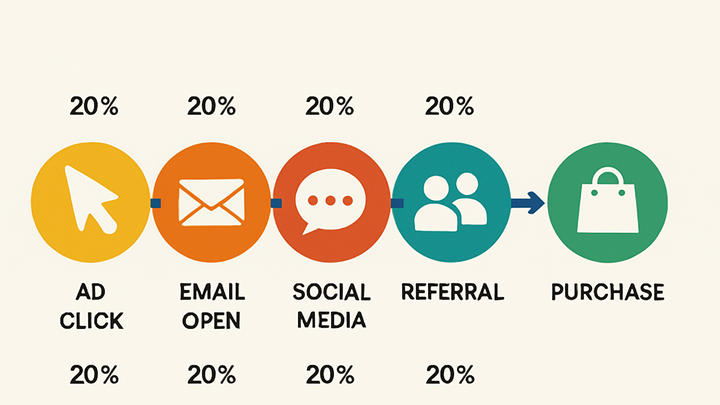Published on 2025-06-26T05:32:56Z
What is Linear Attribution? Examples and Explanation
Linear Attribution is an analytics model that assigns equal credit to every interaction a customer has before converting. It views each touchpoint—such as ad clicks, email opens, and social media engagement—as equally important, distributing the conversion credit evenly. This approach encourages marketers to value all channels that contribute to the customer journey, not just the first or last interaction. While simple to implement and transparent, it may overlook the varying influence of different touchpoints. Use Linear Attribution to gain a balanced overview of your marketing performance and identify channels that consistently support conversions.
Linear attribution
Linear Attribution assigns equal credit to each touchpoint in a customer journey, offering a balanced view of marketing performance.
Definition and Concept
Linear Attribution distributes conversion credit evenly across all touchpoints in the customer journey. Each interaction—from the first ad click to the final site visit—is assigned the same weight, simplifying the evaluation of channel performance.
-
Equal credit across touchpoints
Every user interaction leading to a conversion gets the same portion of credit, ensuring no channel is undervalued or overvalued.
-
Use cases
Ideal for holistic campaigns where each touchpoint is intentionally designed to contribute, such as brand-building or content-driven strategies.
Advantages and Limitations
While Linear Attribution offers simplicity and fairness, it may mask the true impact of high-influence touchpoints. Consider these pros and cons:
-
Advantages
Straightforward to implement, promotes balanced channel valuation, and fosters transparency among stakeholders.
-
Simplicity
Easy to understand and explain to team members and executives.
-
Balanced insights
Highlights all contributing channels, avoiding bias toward first or last interactions.
-
-
Limitations
Assumes all touchpoints have equal influence, potentially misrepresenting the true drivers of conversion.
-
Lack of differentiation
Fails to account for touchpoints with disproportionate impact on the decision-making process.
-
Overlooking context
Ignores temporal factors like recency and frequency that can affect a touchpoint’s effectiveness.
-
Implementing Linear Attribution
Set up Linear Attribution in your analytics platform to begin capturing balanced conversion data across channels.
-
PlainSignal (cookie-free analytics)
PlainSignal provides a lightweight, privacy-focused analytics solution. To implement Linear Attribution, add their tracking code and select the Linear model in the dashboard.
-
Tracking code
<link rel="preconnect" href="//eu.plainsignal.com/" crossorigin /> <script defer data-do="yourwebsitedomain.com" data-id="0GQV1xmtzQQ" data-api="//eu.plainsignal.com" src="//cdn.plainsignal.com/plainsignal-min.js"></script> -
Activate linear model
In the PlainSignal dashboard, navigate to Attribution Models and choose Linear to apply equal credit distribution.
-
-
Google analytics 4 (GA4)
GA4 natively supports multiple attribution models, including Linear. Use the Model Comparison report to view Linear Attribution data.
-
Accessing model comparison
Go to Reports > Advertising > Attribution > Model comparison, then select Linear for your target conversion.
-
Custom analysis
Use the Explore feature to build detailed Linear Attribution reports and compare performance against other models.
-
Best Practices
Maximize the effectiveness of Linear Attribution with these guidelines:
-
Combine models
Compare Linear results with Position-Based or Time Decay models to uncover touchpoint influence variations.
-
Regularly audit data
Ensure tracking accuracy and revisit attribution settings after significant campaign changes or platform updates.
-
Educate your team
Train stakeholders on the implications of equal credit distribution to set realistic expectations for channel performance.
